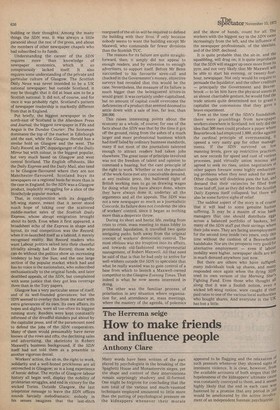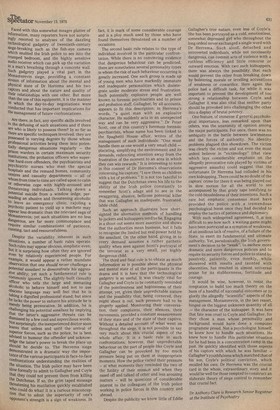The Herrema seige
How to make friends and influence people
Anthony Clare
Many words have been written of the part played by psychologists in the breaking of the Spaghetti House and Monasterevin sieges, yet the shape and content of their interventions remain surprisingly shadowy and ill-formed. One might be forgiven for concluding that the sum total of the various and much-vaunted techniques employed amounted to little more than the putting of psychological pressure on the kidnappers whenever their morale
appeared to be flagging and the relaxation of such pressure whenever they showed signs °f imminent violence. It is clear, however, from the available accounts of both sieges that the hopelessness of the kidnappers' ultimate cause was constantly conveyed to them, and it seems highly likely that the end in each case vial hastened by a promise that any period in jai' would be ameliorated by the active involvement of an independent forensic psychiatrist.
Faced with this somewhat meagre platter of information, many reporters have not surprisingly resorted to analyses of the dazzling technological gadgetry of twentieth-century siege-breaking such as the fish-eye camera Which enabled the Irish police to see into the cramped bedroom, and the highly sensitive audio receiver which can pick up the variation in a man's breathing through a concrete wall. Such gadgetry played a vital part in the Monasterevin siege, providing a constant stream of information about the mental and Physical state of Dr Herrema and his two captors and about the nature and quality of their relationships with one other. But more than the use of this equipment, it is the manner in which the day-to-day negotiations were conducted that has important implications for the management of future confrontations.
Are there, in fact, any specific skills involved in the defusing of such situations and if there are who is likely to possess them? In so far as there are specific techniques involved, they are Possessed in varying degrees by those whose Professional activities bring them into potentiallY dangerous situations regularly — the prison warders in certain Maximum security institutions, the probation officers who supervise hard-core offenders, the psychiatrists and psychiatric nurses who man the special hospitals and the remand homes, community centres and casualty departments — all of Whom from time to time are called upon to calm Or otherwise cope with highly-aroused and threatening individuals. Talking down a Potential suicide from a window ledge, persuading an abusive and threatening alcoholic to leave an emergency clinic, cajoling a PsYchotic patient to yield up a machete may appear less dramatic than the televised saga of Monasterevin; yet such situations are no less dangerous, are far more commonplace and require similar combinations of patience, cunning, tact and resourcefulness.
Despite the variability inherent in such situations, a number of basic rules operate. Such rules may appear obvious, simplistic even; but it is surprising how often they are ignored even by relatively experienced people. For example, it would appear a rather mundane observation that one should never challenge a Potential assailant to demonstrate his aggresswe ability; yet such a fundamental rule is contrrionly ignored. The slightly-built casualty Officer who tells the large and menacing alcoholic to behave himself and not to use Obscene language may well feel that he is taking a dignified professional stand; but since he lacks the power to enforce his attitude he is Merely being provocative. In addition, he is challenging his potential assailant by implying that the latter's aggressive threats can be dismissed by a few cool and supercilious words. Not surprisingly, the inexperienced doctor soon learns that unless and until the arrival of superior forces, such as the police, he is best advised to humour the offender and acknowledge the latter's power to break the place up Should he decide to. The Herrema siege demonstrated in a dramatic way the importance of the various participants in face-to-face confrontations understanding the realities of the situation. The Irish police may have been sloW formally to admit to Gallagher and Coyle that they could not prevent them from killing the Dutchman. If so, the grim taped message threatening his mutilation quickly established NVI10 could do what! It is a curious misconception that to admit the superiority of one's oPPonent's strength is a sign of weakness. In
fact, it is mark of some considerable courage and is a ploy much used by those who have found themselves threatened on a number of occasions.
The second basic rule relates to the type of individual involved in the particular confrontation. While there is no convincing evidence that dangerous behaviour can be predicted, there are nonetheless several personality types in whom the risk of such behaviour occurring is greatly increased. One such group is made up of young men who have markedly immature and inadequate personalities which disintegrate under moderate stress and frustration. Such potentially explosive people are well known to forensic psychiatrists and to prison and probation staff. Gallagher, by all accounts, appears to fit this description; in Herrema's words, "a quiet man with an explosive character. He suddenly acts in an unexpected way and can be very aggressive." Dr Peter Scott, one of this country's foremost forensic psychiatrists, whose name has been linked to the Spaghetti House affair, writes of the management of such individuals: "One must handle them as one would a very small child — placating, simplifying the environment and its demands, redirecting attention away from the frustration of the moment to an area in which they can win rewards." It is interesting to note in this context of Dr Herrema's observations concerning his captors: "1 saw them as children with a lot of problems." It is not too fanciful to suggest that the Dutchman owes his life to the ability of the Irish police constantly to remember Scott's adage and to see in the swaggering, abusive, bellicose potential killer that was Gallagher an inadequate, frustrated, labile child.
Such an approach illustrates how shortsighted the alternative methods of handling hi-jackers and kidnappers tend to be. Engaging in a shoot-out seems more assertive and shows that the authorities mean business, but it fails to recognise the limited but real power held by the assailant. On the other hand, giving in to every demand assumes a rather pathetic quality when seen against Scott's portrayal of the terrorist as a very small, yet highly dangerous child. The third and final rule is to obtain as much information as is possible about the physical and mental state of all the participants in the drama and it is here that the technological gadgetry is so useful. It was clearly vital for Gallagher and Coyle to be constantly reminded of the pointlessness and hoplessness of their attempt, yet, given their unpredictable nature and the possibility that, being cornered, they might shoot it out, such pressure had to be gingerly applied. Monitoring their conversation, their complaints, their silences, their movements, provided a constant measurement of their state and of the state of their captive. Without a detailed account of what went on throughout the siege, it is not possible to say very much about this crucial aspect of the whole affair. It is a basic rule in such confrontations, however, that unpredictable behaviour on the part of people like Coyle and Gallagher can be provoked by too much pressure being put on them at inappropriate moments. How the police varied their pressure — at what moments they reminded the two of the futility of their mission and when they eased off and talked of other and less arousing • matters — will be questions of considerable interest to the colleagues of the Irish police working in police forces in this country and abroad.
Despite the publicity we know little of Eddie , Gallagher's true nature, even less of Coyle's. She has been portrayed as a cold, emotionless, somewhat depressed girl who throughout the long ordeal never exchanged a single word with Dr Herrema. Such aloof, detached and introverted individuals, while not necessarily dangerous, can commit acts of violence with a ruthless efficiency and little remorse or outward emotion. With two such kidnappers, there was always the possibility that each would prevent the other from breaking down by bolstering morale or levelling accusations of weakness or cowardice. Here again the police had a difficult task, for while it was important to prevent the development of too strong a relationship between Coyle and Gallagher it was also vital that neither party should be provoked into challenging the other into a display of brutal potency.
One feature, of immense if general psychological importance, less remarked upon than others, was the unanimity of opinion among the major participants. For once, there was no ambiguity in the battle between lawlessness and the forces of authority. No identity problems plagued this showdown. The victim was clearly the victim and not even the most ardent believer in "victimology" (that view which lays considerable emphasis on the allegedly provocative role played by victims of aggressive assaults) could suggest that the unfortunate Dr Herrema had colluded in his own kidnapping. There could be no doubt of the captors' crime for there it was being played out in slow motion for all the world to see accompanied by that grisly tape testifying to the cold-bloodedness of their intentions. Such a rare but emphatic consensus must have provided the police with a tremendous psychological boost once they had decided to employ the tactics of patience and diplomacy.
With such widespread agreement, it is not difficult to see how such a waiting game might have been portrayed as a sympton of weakness, of an insidious lack of resolve, of a failure of the State, to exert its fundamental and ultimate authority. Yet, paradoxically, the Irish government's decision to be "weak", to eschew more dramatic and more dangerous policies and to require its security forces and police to stand by passively, patiently, even meekly, while showered with insults and taunted with obscenities, has resulted in almost universal praise for its stubbornness, fortitude and courage.
It would be wise, however, to resist the temptation to build too much theory on the basis of a handful of successful outcomes or to glorify the allegedly "scientific" aspects of the management. Monasterevin, in the last resort, hinged on the biggest unknown quantity of all — the character of the kidnapper. It was here that fate was cruel to Coyle and Gallagher, for they chose a man whose personality and background would have done a computer programme proud. Not a psychologist himself, he knew how to handle such situations. He knew how to handle this particular situation for he had been in a concentration camp in the past. He quickly identified with those aspects of his captors with which he was familiar — Gallagher's youthfulness which matched that of his son, Coyle's political conviction, which recalled his own. Dr Herrema was the crucial card in the whole, extraordinary story and it would be well for those tempted to construct an elaborate theory of siege control to remember that crucial fact.
Dr Anthony Clare is Research Senior Registrar at the Institute of Psychiatry



































 Previous page
Previous page